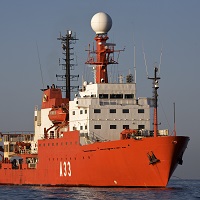Keyword
80
5 record(s)
Type of resources
Categories
Topics
INSPIRE themes
Keywords
Contact for the resource
Provided by
Years
Formats
Status
-
The objective of cruise JC103 was to service the moorings of the RAPID 26°N project that are deployed to monitor the Atlantic Meridional Overturning Circulation. For each mooring instruments were recovered, data were downloaded and instruments were redeployed. A number of CTDs were made to calibrate the instruments from the moorings. During passage from port of Spain to Nassau trial CTDs were completed in the waters of the Turks and Caicos Islands. After departing Nassau on 29th April work commenced on the western boundary sub-array comprising of moorings WBADCP, WBAL, WB1, WB2, WB2l, WB2h, WB4 and WB4L. The ship returned to Nassau on 6th May to disembark one person before sailing east once again. The final mooring of the wester sub-array was serviced on 8th May before continuing east to the mid-Atlantic Ridge (MAR) sub-array. Work on the MAR sub-array commenced on 13th May at mooring MAR0. The other moorings in this sub-array were MAR1, MAR1L, MAR2, MAR3 and MAR3L were all completed by 18th May. On the following day the NOG mooring was deployed and as the ship transited to the astern sub-array the first of 5 Argo floats was deployed on 21st May. The eastern boundary sub-array starts at EB1, which was serviced on 23rd May. Following this moorings at EB1L, EBHi, EBH1, EBH2, EBh3,EBh4 and EBH4L in the following days up until 31st May. A number of CTDs were completed form 31st may to 2nd June.
-
Cruise D344 was primarily used for the annual servicing of the eastern boundary and mid-Atlantic ridge moorings that form part of the RAPID-MOC mooring array across the North Atlantic at 26°N. In addition, the easternmost western boundary mooring, WB6, was serviced and the trial current meter mooring off the island of Abaco, WB-CM, was recovered. As the Discovery had made a faster passage than anticipated, a number of CTD stations were performed along 24° 30'N to augment the hydrography section scheduled to take place in January 2010. The instruments deployed on the RAPID-MOC array consist of bottom pressure recorders, CTD loggers, and current meters which, combined with time series measurements of the Florida Channel Current, and wind stress estimates, will be used to determine the strength and structure of the MOC at 26.5°N.
-
This project was a hydrographic section at latitude 24°N, with physical, chemical and biological measurements. The section was a complete section from continent to continent from North America (Caribbean) to Africa (off the coast of the Western Sahara). The section started and ended in 200 metres water depth, at the edge of the continental shelf. This was a contribution to the international CLIVAR/Carbon repeat hydrography program (http://ioc3.unesco.org/ioccp/Hydrography/New_GlobalMap.html). Climate change will be studied by comparing the new data with historical measurements. Ocean heat transport plays a major role in the coupled ocean-atmosphere climate system. We will study the present-day circulation by calculating the heat and freshwater transported by the ocean across the 24°N latitude. The ocean western boundary current system, in this case the Gulf Stream flowing through the Florida Strait, plays a crucial role in the oceanic heat transport. Therefore a crossing of the Florida Strait will be carried out to establish the status of this important ocean feature. All data arising from the cruise will be lodged and made available via the British Oceanographic Data Centre (BODC), UK.
-

Realizacion seccion A5 programa hidrografico de WOCE a lo largo paralelo 24.5°N Atlantico y seccion a traves del Estrecho de Florida (26°N)\n- Caracterizar las masas de agua\n- Transporte y flujos calor, agua y sustancias quimicas\n- Variabilidad
-
A circumnavigation oceanographic expedition to generate a high resolution inventory of global change impact on the ecosystem of the ocean, researching its biodiversity in the deep.
 Catálogo de datos del IEO
Catálogo de datos del IEO